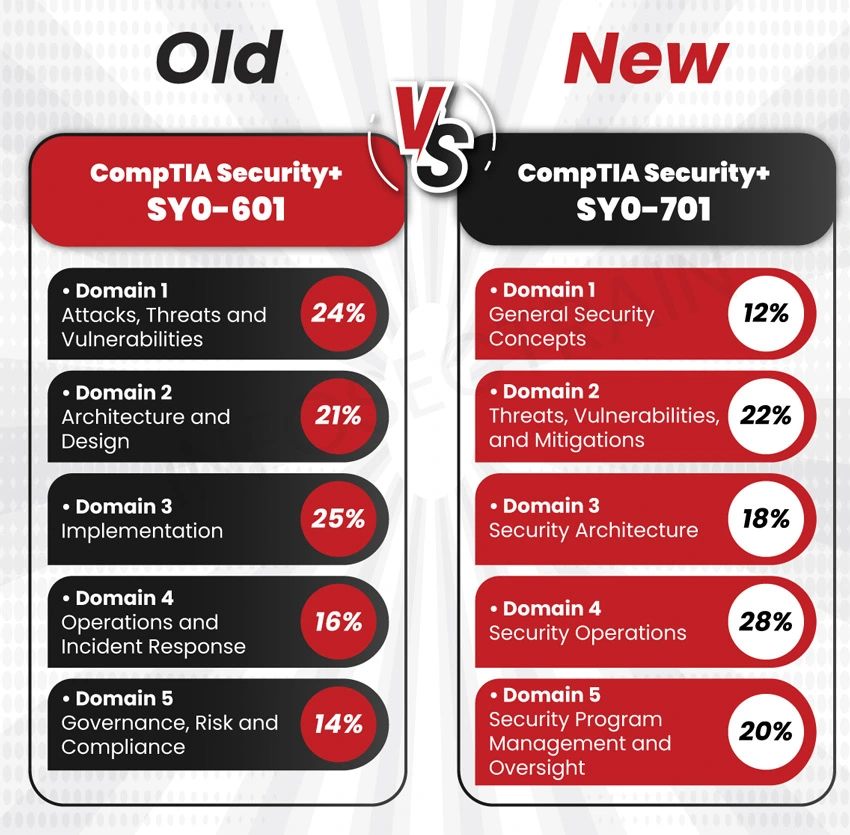Program Highlights
In the ever-evolving cybersecurity landscape, the latest version of the CompTIA Security+ (SY0-701) training course from InfosecTrain is your gateway to mastering the core skills necessary to secure data and information systems in the digital age. With a focus on the latest threats, automation, zero trust principles, IoT security, risk management, and more, this course equips participants to pass the Security+ SY0-701 exam on their first attempt.
40-Hour LIVE Instructor-led Training
CompTIA Authorized Partner
Practical Training on Latest Tools
98% Exam Pass Rate
Learn from Certified Trainers
Career Guidance and Mentorship
Post Training Support
Access to Recorded Sessions
Learning Schedule
- upcoming classes
- corporate training
- 1 on 1 training
| 03 May - 08 Jun | Online | Weekend | 19:00 - 23:00 IST | BATCH OPEN | |
| 25 May - 05 Jul | Online | Weekend | 19:00 - 23:00 IST | Only 2 Seat Available | |
| 28 Jun - 03 Aug | Online | Weekend | 19:00 - 23:00 IST | BATCH OPEN |
Why Choose Our Corporate Training Solution
- Upskill your team on the latest tech
- Highly customized solutions
- Free Training Needs Analysis
- Skill-specific training delivery
- Secure your organizations inside-out
Why Choose 1-on-1 Training
- Get personalized attention
- Customized content
- Learn at your dedicated hour
- Instant clarification of doubt
- Guaranteed to run
Can't Find a Suitable Schedule? Talk to Our Training Advisor
Domain 1:
General Security Concepts (12%)
- 1.1: Compare and Contrast Various Types of Security Controls
- Categories
- Technical
- Managerial
- Operational
- Physical
- Control
- Preventive
- Deterrent
- Detective
- Corrective
- Compensating
- Directive
- Categories
- 1.2: Summarize Fundamental Security Concepts
- Confidentiality, Integrity, and Availability (CIA)
- Non-Repudiation
- Authentication, Authorization, and Accounting (AAA)
- Authenticating People
- Authenticating Systems
- Authorization Models
- Gap Analysis
- Zero Trust
- Control Plane
- Adaptive Identity
- Threat Scope Reduction
- Policy-Driven Access Control
- Policy Administrator
- Policy Engine
- Data Plane
- Implicit Trust Zones
- Subject/System
- Policy Enforcement Point
- Physical Security
- Bollards
- Access Control Vestibule
- Fencing
- Video Surveillance
- Security Guard
- Access Badge
- Lighting
- Sensors
- Infrared
- Pressure
- Microwave
- Ultrasonic
- Deception and Disruption Technology
- Honeypot
- Honeynet
- Honeyfile
- Honeytoken
- 1.3: Explain the Importance of Change Management Processes and the Impact to Security
- Business Processes Impacting Security Operation
- Approval process
- Ownership
- Stakeholders
- Impact Analysis
- Test Results
- Backout Plan
- Maintenance Window
- Standard Operating Procedure
- Technical Implications
- Allow Lists/Deny Lists
- Restricted Activities
- Downtime
- Service Restart
- Application Restart
- Legacy Applications
- Dependencies
- Documentation
- Updating Diagrams
- Updating Policies/Procedures
- Version Control
- Business Processes Impacting Security Operation
- 1.4: Explain the Importance of Using Appropriate Cryptographic Solutions
- Public Key Infrastructure (PKI)
- Public Key
- Private Key
- Key Escrow
- Encryption
- Level
- Full-Disk
- Partition
- File
- Volume
- Database
- Record
- Transport/Communication
- Asymmetric
- Symmetric
- Key Exchange
- Algorithms
- Key length
- Level
- Tools
- Trusted Platform Module (TPM)
- Hardware Security Module (HSM)
- Key Management System
- Secure Enclave
- Obfuscation
- Steganography
- Tokenization
- Data Masking
- Hashing
- Salting
- Digital Signatures
- Key Stretching
- Blockchain
- Open Public Ledger
- Certificates
- Certificate Authorities
- Certificate Revocation Lists (CRLs)
- Online Certificate Status Protocol (OCSP)
- Self-Signed
- Third-Party
- Root of Trust
- Certificate Signing Request (CSR) Generation
- Wildcard
- Public Key Infrastructure (PKI)
Domain 2:
Threats, Vulnerabilities, and Mitigations (22%)
- 2.1: Compare and Contrast Common Threat Actors and Motivations
- Threat Actors
- Nation-State
- Unskilled Attacker
- Hacktivist
- Insider Threat
- Organized Crime
- Shadow IT
- Attributes of Actors
- Internal/External
- Resources/Funding
- Level of Sophistication/Capability
- Motivations
- Data Exfiltration
- Espionage
- Service Disruption
- Blackmail
- Financial Gain
- Philosophical/Political Beliefs
- Ethical
- Revenge
- Disruption/Chaos
- War
- Threat Actors
- 2.2: Explain Common Threat Vectors and Attack Surfaces
- Message-Based
- Short Message Service (SMS)
- Instant Messaging (IM)
- Image-Based
- File-Based
- Voice Call
- Removable Device
- Vulnerable Software
- Client-Based vs. Agentless
- Unsupported Systems and Applications
- Unsecure Networks
- Wireless
- Wired
- Bluetooth
- Open Service Ports
- Default Credentials
- Supply Chain
- Managed Service Providers (MSPs)
- Vendors
- Suppliers
- Human Vectors/Social Engineering
- Phishing
- Vishing
- Smishing
- Misinformation/Disinformation
- Impersonation
- Business Email Compromise
- Pretexting
- Watering Hole
- Brand Impersonation
- Typosquatting
- Message-Based
- 2.3: Explain Various Types of Vulnerabilities
- Application
- Memory Injection
- Buffer Overflow
- Race Conditions
- Time-of-Check (TOC)
- Time-of-Use (TOU)
- Malicious Update
- Operating System (OS)-Based
- Web-Based
- Structured Query Language (SQL) Injection
- Cross-Site Scripting (XSS)
- Hardware
- Firmware
- End-of-Life
- Legacy
- Virtualization
- Virtual Machine (VM) Escape
- Resource Reuse
- Cloud-Specific
- Supply Chain
- Service Provider
- Hardware Provider
- Software Provider
- Cryptographic
- Misconfiguration
- Mobile Device
- Side Loading
- Jailbreaking
- Application
- 2.4: Given a Scenario, Analyze Indicators of Malicious Activity
- Malware Attacks
- Ransomware
- Trojan
- Worm
- Spyware
- Bloatware
- Virus
- Keylogger
- Logic Bomb
- Rootkit
- Physical Attacks
- Brute Force
- Radio Frequency Identification (RFID) Cloning
- Environmental
- Network Attacks
- Distributed Denial-of-Service (DDoS)
- Domain Name System (DNS) Attacks
- Wireless
- On-Path
- Credential Replay
- Malicious Code
- Application Attacks
- Injection
- Buffer Overflow
- Replay
- Privilege Escalation
- Forgery
- Directory Traversal
- Cryptographic Attacks
- Downgrade
- Collision
- Birthday
- Password Attacks
- Spraying
- Brute Force
- Indicators
- Account Lockout
- Concurrent Session Usage
- Blocked Content
- Impossible Travel
- Resource Consumption
- Resource Inaccessibility
- Out-of-Cycle Logging
- Published/Documented
- Missing Logs
- Malware Attacks
- 2.5: Explain the Purpose of Mitigation Techniques Used to Secure the Enterprise
- Segmentation
- Access Control
- Access Control List (ACL)
- Permissions
- Application Allow List
- Isolation
- Patching
- Encryption
- Monitoring
- Least Privilege
- Configuration Enforcement
- Decommissioning
- Hardening Techniques
- Encryption
- Installation of Endpoint Protection
- Host-Based Firewall
- Host-Based Intrusion Prevention System (HIPS)
- Disabling Ports/Protocols
- Default Password Changes
- Removal of Unnecessary Software
Domain 3:
Security Architecture (18%)
- 3.1: Compare and Contrast Security Implications of Different Architecture Models
- Architecture and Infrastructure Concepts
- Cloud
- Responsibility Matrix
- Hybrid Considerations
- Third-Party Vendors
- Infrastructure as Code (IaC)
- Serverless
- Microservices
- Network Infrastructure
- On-Premises
- Centralized vs. Decentralized
- Containerization
- Virtualization
- IoT
- Industrial Control Systems (ICS)
- Supervisory Control and Data Acquisition (SCADA)
- Real-Time Operating System (RTOS)
- Embedded Systems
- High availability
- Cloud
- Considerations
- Availability
- Resilience
- Cost
- Responsiveness
- Scalability
- Ease of Deployment
- Risk Transference
- Ease of Recovery
- Patch Availability
- Inability to Patch
- Power
- Compute
- Architecture and Infrastructure Concepts
- 3.2: Given a Scenario, Apply Security Principles to Secure Enterprise
- Infrastructure Considerations
- Device Placement
- Security Zones
- Attack Surface
- Connectivity
- Failure Modes
- Fail-Open
- Fail-Closed
- Device Attribute
- Active vs. Passive
- Inline vs. Tap/Monitor
- Network Appliances
- Jump Server
- Proxy Server
- Intrusion Prevention System (IPS)/Intrusion Detection System (IDS)
- Load Balancer
- Sensor
- Port Security
- 802.1X
- Extensible Authentication
- Firewall Types
- Web Application Firewall (WAF)
- Unified Threat Management (UTM)
- Next-Generation Firewall (NGFW)
- Layer 4/Layer 7
- Secure Communication/Access
- Virtual Private Network (VPN)
- Remote Access
- Tunneling
- Transport Layer Security (TLS)
- Internet Protocol Security (IPSec)
- Software-Defined Wide Area Network (SD-WAN)
- Secure Access Service Edge (SASE)
- Selection of Effective Controls
- Infrastructure Considerations
- 3.3: Compare and Contrast Concepts and Strategies to Protect Data
- Data Types
- Regulated
- Trade Secret
- Intellectual Property
- Legal Information
- Financial Information
- Human and Non-Human-Readable
- Data Classifications
- Sensitive
- Confidential
- Public
- Restricted
- Private
- Critica
- General Data Considerations
- Data States
- Data at Rest
- Data in Transit
- Data in Use
- Data Sovereignty
- Geolocation
- Data States
- Methods to Secure Data
- Geographic Restrictions
- Encryption
- Hashing
- Masking
- Tokenization
- Obfuscation
- Segmentation
- Permission Restrictions
- Data Types
- 3.4: Explain the Importance of Resilience and Recovery in Security Architecture’
- High Availability
- Load Balancing vs. Clustering
- Site Considerations
- Hot
- Cold
- Warm
- Geographic Dispersion
- Platform Diversity
- Multi-Cloud Systems
- Continuity of Operations
- Capacity Planning
- People
- Technology
- Infrastructure
- Testing
- Tabletop Exercises
- Fail over
- Simulation
- Parallel Processing
- Backups
- Onsite/Offsite
- Frequency
- Encryption
- Snapshots
- Recovery
- Replication
- Journaling
- Power
- Generators
- Uninterruptible Power Supply (UPS)
- High Availability
Domain 4:
Security Operations (28%)
- 4.1: Given a Scenario, Apply Common Security Techniques to Computing
- Secure Baselines
- Establish
- Deploy
- Maintain
- Hardening Targets
- Mobile Devices
- Workstations
- Switches
- Routers
- Cloud Infrastructure
- Servers
- ICS/SCADA
- Embedded Systems
- RTOS
- IoT devices
- Wireless Devices
- Installation Considerations
- Site Surveys
- Heat Maps
- Installation Considerations
- Mobile Solutions
- Mobile Device Management (MDM)
- Deployment Models
- Bring your Own Device (BYOD)
- Corporate-Owned, Personally Enabled (COPE)
- Choose Your Own Device (CYOD)
- Connection Methods
- Cellular
- Wi-Fi
- Bluetooth
- Wireless Security Settings
- Wi-Fi Protected Access 3 (WPA3)
- AAA/Remote Authentication
- Dial-In User Service (RADIUS)
- Cryptographic Protocols
- Authentication Protocols
- Application Security
- Input Validation
- Secure Cookies
- Static Code Analysis
- Code Signing
- Sandboxing
- Monitoring
- Secure Baselines
- 4.2: Explain the Security Implications of Proper Hardware, Software, and Data Asset Management
- Acquisition/Procurement Process
- Assignment/Accounting
- Ownership
- Classification
- Monitoring/Asset Tracking
- Inventory
- Enumeration
- Disposal/Decommissioning
- Sanitization
- Destruction
- Certification
- Data retention
- 4.3: Explain Various Activities Associated with Vulnerability Management
- Identification Methods
- Vulnerability Scan
- Application Security
- Static Analysis
- Dynamic Analysis
- Package Monitoring
- Threat Feed
- Open-Source Intelligence (OSINT)
- Proprietary/Third-Party
- Information-Sharing Organization
- Dark Web
- Penetration Testing
- Responsible Disclosure Program
- Bug Bounty Program
- System/Process Audit
- Analysis
- Confirmation
- False Positive
- False Negative
- Prioritize
- Common Vulnerability Scoring System (CVSS)
- Common Vulnerability Enumeration (CVE)
- Vulnerability Classification
- Exposure Factor
- Environmental Variables
- Industry/Organizational Impact
- Risk Tolerance
- Confirmation
- Vulnerability Response and Remediation
- Patching
- Insurance
- Segmentation
- Compensating Controls
- Exceptions and Exemptions
- Validation of Remediation
- Rescanning
- Audit
- Verification
- Reporting
- Identification Methods
- 4.4: Explain Security Alerting and Monitoring Concepts and Tools
- Monitoring Computing Resources
- Systems
- Applications
- Infrastructure
- Activities
- Log Aggregation
- Alerting
- Scanning
- Reporting
- Archiving
- Alert Response and Remediation/ Validation
- Quarantine
- Alert Tuning
- Tools
- Security Content Automation Protocol (SCAP)
- Benchmarks
- Agents/Agentless
- Security Information and Event Management (SIEM)
- Antivirus
- Data Loss Prevention (DLP)
- Simple Network Management Protocol (SNMP) Traps
- NetFlow
- Vulnerability Scanners
- Monitoring Computing Resources
- 4.5: Given a Scenario, Modify Enterprise Capabilities to Enhance Security
- Firewall
- Rules
- Access Lists
- Ports/Protocols
- Screened Subnets
- IDS/IPS
- Trends
- Signatures
- Web Filter
- Agent-Based
- Centralized Proxy
- Universal Resource Locator (URL) Scanning
- Content Categorization
- Block Rules
- Reputation
- Operating System Security
- Group Policy
- SELinux
- Implementation of Secure Protocols
- Protocol Selection
- Port Selection
- Transport Method
- DNS Filtering
- Email Security
- Domain-based Message
- Authentication Reporting and Conformance (DMARC)
- Domain Keys Identified Mail (DKIM)
- Sender Policy Framework (SPF)
- Gateway
- File Integrity Monitoring
- DLP
- Network Access Control (NAC)
- Endpoint Detection and Response (EDR)/Extended Detection and Response (XDR)
- User Behavior Analytics
- Firewall
- 4.6: Given a Scenario, Implement and Maintain Identity and Access
- Provisioning/De-provisioning user Accounts
- Permission Assignments and Implications
- Identity Proofing
- Federation
- Single Sign-On (SSO)
- Lightweight Directory Access Protocol (LDAP)
- Open Authorization (OAuth)
- Security Assertions Markup Language (SAML)
- Interoperability
- Attestation
- Access Controls
- Mandatory
- Discretionary
- Role-Based
- Rule-Based
- Attribute-Based
- Time-of-Day Restrictions
- Least Privilege
- Multi Factor Authentication
- Implementations
- Biometrics
- Hard/Soft Authentication Tokens
- Security Keys
- Factors
- Something You Know
- Something You Have
- Something You Are
- Somewhere You Are
- Implementations
- Password Concepts
- Password Best Practices
- Length
- Complexity
- Reuse
- Expiration
- Age
- Password Managers
- Passwordless
- Password Best Practices
- Privileged Access Management Tools
- Just-in-Time Permissions
- Password Vaulting
- Ephemeral Credentials
- 4.7: Explain the Importance of Automation and Orchestration Related to Secure Operations
- Use Cases of Automation and Scripting
- User Provisioning
- Resource Provisioning
- Guard Rails
- Security Groups
- Ticket Creation
- Escalation
- Enabling/Disabling Services and Access
- Continuous Integration and Testing
- Integrations and Application Programming Interfaces (APIs)
- Benefits
- Efficiency/Time Saving
- Enforcing Baselines
- Standard Infrastructure Configurations
- Scaling in a Secure Manner
- Employee Retention
- Reaction Time
- Workforce Multiplier
- Other Considerations
- Complexity
- Cost
- Single Point of Failure
- Technical Debt
- Ongoing Supportability
- Use Cases of Automation and Scripting
- 4.8: Explain Appropriate Incident Response Activities
- Process
- Preparation
- Detection
- Analysis
- Containment
- Eradication
- Recovery
- Lessons learned
- Training
- Testing
- Tabletop Exercise
- Simulation
- Root Cause Analysis
- Threat Hunting
- Digital Forensics
- Legal Hold
- Chain of Custody
- Acquisition
- Reporting
- Preservation
- E-Discovery
- Process
- 4.9: Given a Scenario, Use Data Sources to Support an Investigation
- Log Data
- Firewall Logs
- Application Logs
- Endpoint Logs
- OS-Specific Security Logs
- IPS/IDS Logs
- Network Logs
- Metadata
- Data Sources
- Vulnerability Scans
- Automated Reports
- Dashboards
- Packet Captures
- Log Data
Domain 5:
Security Program Management and Oversight (20%)
- 5.1: Summarize Elements of Effective Security Governance
- Guidelines
- Policies
- Acceptable Use Policy (AUP)
- Information Security Policies
- Business Continuity
- Disaster Recovery
- Incident Response
- Software Development Lifecycle (SDLC)
- Change Management
- Standards
- Password
- Access Control
- Physical Security
- Encryption
- Procedures
- Change Management
- Onboarding/Offboarding
- Playbooks
- External Considerations
- Regulatory
- Legal
- Industry
- Local/Regional
- National
- Global
- Monitoring and Revision
- Types of Governance Structures
- Boards
- Committees
- Government Entities
- Centralized/Decentralized
- Roles and Responsibilities for Systems and Data
- Owners
- Controllers
- Processors
- Custodians/Stewards
- 5.2: Explain Elements of the Risk Management Process
- Risk Identification
- Risk Assessment
- Ad hoc
- Recurring
- One-Time
- Continuous
- Risk Analysis
- Qualitative
- Quantitative
- Single Loss Expectancy (SLE)
- Annualized Loss Expectancy (ALE)
- Annualized Rate of Occurrence (ARO)
- Probability
- Likelihood
- Exposure Factor
- Risk Register
- Key Risk Indicators
- Risk Owners
- Risk Threshold
- Risk Tolerance
- Risk Appetite
- Expansionary
- Conservative
- Neutral
- Risk Management Strategies
- Transfer
- Accept
- Exemption
- Exception
- Avoid
- Mitigate
- Risk Reporting
- Business Impact Analysis
- Recovery Time Objective (RTO)
- Recovery Point Objective (RPO)
- Mean Time to Repair (MTTR)
- Mean Time Between Failures (MTBF)
- 5.3: Explain the Processes Associated with Third-Party Risk Assessment and Management
- Vendor Assessment
- Penetration Testing
- Right-to-Audit Clause
- Evidence of Internal Audits
- Independent Assessments
- Supply Chain Analysis
- Vendor Selection
- Due Diligence
- Conflict of Interest
- Agreement Types
- Service-Level Agreement (SLA)
- Memorandum of Agreement (MOA)
- Memorandum of Understanding (MOU)
- Master Service Agreement (MSA)
- Work Order (WO)/Statement of Work (SOW)
- Non-Disclosure Agreement (NDA)
- Business Partners Agreement (BPA)
- Vendor Monitoring
- Questionnaires
- Rules of Engagement
- Vendor Assessment
- 5.4: Explain Types and Purposes of Audits and Assessments
- Attestation
- Internal
- Compliance
- Audit Committee
- Self-Assessments
- External
- Regulatory
- Examinations
- Assessment
- Independent Third-Party Audit
- Penetration Testing
- Physical
- Offensive
- Defensive
- Integrated
- Known Environment
- Partially Known Environment
- Unknown Environment
- Reconnaissance
- Active
- Passive
- 5.5: Given a Scenario, Implement Security Awareness Practices
- Phishing
- Campaigns
- Recognizing a Phishing Attempt
- Responding to Reported Suspicious Messages
- Anomalous Behavior Recognition
- Risky
- Unexpected
- Unintentional
- User Guidance and Training
- Policy/Handbooks
- Situational Awareness
- Insider Threat
- Password Management
- Removable Media and Cables
- Social Engineering
- Operational Security
- Hybrid/Remote Work Environments
- Reporting and Monitoring
- Initial
- Recurring
- Development
- Execution
- Phishing
| Exam Code | SY0-601 | SY0-701 |
| Launch Date | 12th, November 2020 | 7th, November 2023 |
| Exam Description | The CompTIA Security+ certification exam ensures that candidates possess the expertise and proficiencies necessary to evaluate the security standing of enterprise environments, suggest and execute suitable security solutions, oversee and secure hybrid environments that encompass cloud, mobile, and IoT, and conduct operations in alignment with relevant laws and regulations, encompassing governance, risk management, and compliance principles. Furthermore, it attests to candidates’ ability to effectively identify, assess, and manage security events and incidents. | |
| Recommended Experience | CompTIA Network+ and two years of experience in IT administration with a security focus | CompTIA Network+ and two years of experience working in a security/ systems administrator job role |
| Number of Questions | Maximum of 90 Questions | |
| Exam Format | Multiple Choice and Performance-Based | |
| Exam Duration | 90 Minutes | |
| Passing Score | 750 (on a scale of 100-900) | |
| Languages | English, Japanese, Portuguese, and Spanish | |
| Retirement | July 2024 | TBD – Usually three years after launch |
How We Help You Succeed
Vision
Goal
Skill-Building
Mentoring
Direction
Support
Success
Your Trusted Instructors

10+ Years Of Experience

10+ Years Of Experience

10+ Years Of Experience

7+ years of experience

7+ Years Of Experience
6+ Years of Experience
Words Have Power

The CompTIA Sec+ training session was excellent! Your energy and enthusiasm were infectious, keeping us engaged throughout the session. I appreciated how the practical tips were explained and insights that we could immediately apply to our work. Thank you for your dedication to making this training beneficial.

The Sec+ training was good and well-handled by the trainer. It is exhaustive, but the trainer did his best in touching upon the important concepts and helped to understand using his simple-to-explain approach.

It was a pleasure to talk to the support team for coordinating the workshop for Security+. She helped me in clarifying how the workshop works. The instructor helped explain the topics related to cybersecurity in a visual manner as well.

The Comptia Sec+ training session with InfosecTrain was good and the trainer’s knowledge was awesome. I could clearly understand everything that he taught. I would definitely recommend InfosecTrain to others.

The CompTIA Security+ course content was very good. The instructor has thorough knowledge regarding the course, and particularly, all the concepts were clear during the class, which I really liked. Thank you so much.

The CompTIA Security+ training with Infosec Train gave me good insights on pentesting, a hands on experience and the recordings are helping me to sync in the knowledge shared by the trainer. Absolutely good course for the ones planning to start their journey in cybersecurity.
Success Speaks Volumes
Get a Sample Certificate

Frequently Asked Questions
How long is the CompTIA security+ certification valid?
The CompTIA Security+ certification is valid for three years. One can easily renew the certificate and extend it for three more years through CompTIA’s continuing education (CE) program.
How long does it take to study for the CompTIA Security+ 701 exam?
It depends upon your experience and the knowledge about exam domains you already have. But four to five weeks are sufficient if you study diligently and consistently.
What types of questions are on the CompTIA Security+ SY0-701 exam?
The CompTIA Security+ exam has performance-based multiple-choice questions (MCQs) and drag-and-drop activities to challenge your problem-solving skills. The multiple-choice questions could be single- and multiple-response.
How long is the Security+ SY0-701 exam?
The duration of the Security+ SY0-701 exam is 90 minutes.
What is the passing score for the CompTIA Security+ SY0-701 exam?
The passing score for CompTIA security+ is 750 (on a scale of 100-900).
What sort of job can you get with a CompTIA Security+ SY0-701 certification?
CompTIA Security+ certification can validate a candidate’s skills for job roles such as System Administrator, IT Auditor, Penetration Tester, Network Administrator, Security Engineer, and Consultant.
What if I have recently cleared SY0-601? Would it still be valid?
The CompTIA Security+ certificate will be valid for three years from the day you successfully pass the examination. If a candidate passes the Security+ Exam just before the examination’s retirement, his/her certificate will still be valid for three years.
Is it worthwhile to get a CompTIA Security+ certification?
CompTIA Security+ is a standard approved by the industry to pursue a career in cybersecurity. The certification validates a candidate’s baseline skills that are required to perform core security functions. CompTIA Security+ is compliant with ISO 17024 and approved by the US Department of Defense (DOD). Moreover, companies look for CompTIA security+ credentials while hiring candidates for early-career job roles in cybersecurity.
Where can I take the CompTIA security+ certification exam?
There are two options available for taking the exam.Online testing: In online testing, you can give the exam from any location as per your convenience. A good internet connection and a device having a webcam will be required. In-person testing: In case, due to some reasons you are not able to take an online test, then CompTIA provides you testing options at any of Pearson VUE testing centers located across the globe.
Do I need to earn any other certification before the security+ SYO-701?
There are no mandatory prerequisites for Security+ SY0-701 certification. However, it is recommended to earn CompTIA A+ or CompTIA Network+ certification.






 1800-843-7890 (India)
1800-843-7890 (India)